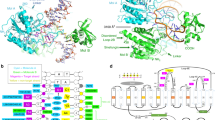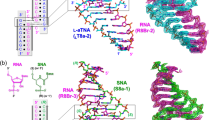Abstract
Actinomycin D (AMD) is used clinically to treat tumours such as Wilms' tumour1 and gestational choriocarcinoma2. It inhibits transcription in most cellular systems3,4, and binds to DNA, not to RNA3–5, with a preference for guanine6. The study of the crystal structure of a 2:1 complex between deoxyguanosine and AMD demonstrated both stacking and hydrogen-bonding interactions between the drug and the guanine ring7. Solution studies8,9 have indicated that the drug binds preferentially to guanine–pyrimidine sequences, such as d(GpC), and that an intercalated complex forms with both DNA10 and DNA fragments11. External binding12 and intercalation10,13 models for the structure of the complex between AMD and DNA have been proposed, but until now no crystal strucutre of a complex between AMD and an oligonucleotide has been reported. As the smallest unit of DNA with the potential for forming an intercalated duplex is a self-complementary deoxydinucleoside monophosphate, we undertook the crystallographic analysis of the 2:1 complex between deoxyguanylyl-3′, 5′-deoxycytidine, d(GpC), and AMD. The complex is found to form an unusual pseudo-intercalated structure.
This is a preview of subscription content, access via your institution
Access options
Subscribe to this journal
Receive 51 print issues and online access
$199.00 per year
only $3.90 per issue
Buy this article
- Purchase on Springer Link
- Instant access to full article PDF
Prices may be subject to local taxes which are calculated during checkout
Similar content being viewed by others
References
Farber, S. J. Am. med. Ass. 198, 826–836 (1966).
Lewis, J. L. Cancer 30, 1517–1521 (1972).
Goldberg, I. H. & Friedman, P. A. A. Rev. Biochem. 40, 775–810 (1971).
Kersten, H. & Kersten, W. in Inhibitors, of Nucleic Acid Synthesis, 40–66 (Springer, Berlin, 1974).
Bunte, T., Novak, U., Friedrich, R. & Moelling, K. Biochim. biophys. Acta 610, 241–247 (1980).
Goldberg, I. H., Rabinowitz, M. & Reich, E. Proc. natn. Acad. Sci. U.S.A. 48, 2094–2101 (1962).
Sobell, H. M., Jain, S. C., Sakore, T. D. & Nordman, C. E. Nature new Biol. 231, 200–205 (1971).
Krugh, T. R. in Topics in Nucleic Acid Structure (ed. Neidle, S.) 197–217 (Macmillan, London, 1981).
Krugh, T. R. & Chen, Y. C. Biochemistry 14, 4912–4922 (1975).
Müller, W. & Crothers, D. M. J. molec. Biol. 35, 251–290 (1968).
Patel, D. J. Biochemistry 13, 2396–2402 (1974).
Hamilton, L. D., Fuller, W. & Reich, E. Nature 198, 538–540 (1963).
Sobell, H. M. & Jain, S. C. J. molec. Biol. 68, 21–34 (1972).
North, A. C. T., Phillips, D. C. & Mathews, F. S. Acta crystallogr. A24, 351–359 (1968).
Wood, W. “DOCK” Interactive Three Dimensional Display and Manipulation of Molecular and Contour Data (ICR Internal Documentation, Philadelphia, 1981).
Rosenberg, J. M., Seeman, N. C., Day, R. O. & Rich, A. J. molec. Biol. 104, 145–167 (1976).
Seeman, N. C., Rosenberg, J. M., Suddath, F. L., Kim, J. J. P. & Rich, A. J. molec. Biol. 104, 109–144 (1976).
Tsai, C.-C., Jain, S. C. & Sobell, H. M. J. molec. Biol. 114, 301–315 (1977).
Neidle, S. et al. Nature 269, 304–307 (1977).
Wang, A. H. J., Nathans, J., van der Marel, G., van Boom, J. H. & Rich, A. Nature 276, 471–474 (1978).
Berman, H. M. & Young, P. R. A. Rev. Biophys. Bioengng 10, 87–114 (1981).
Seeman, N. C., Day, R. O. & Rich, A. Nature 253, 324–326 (1975).
Reinhardt, C. G. & Krugh, T. R. Biochemistry 16, 2890–2895 (1977).
Patel, D. J. Biochim. biophys. Acta 442, 98–108 (1976).
Patel, D. J. Biopolymers 15, 533–558 (1976).
Quigley, G. J. et al. Proc. natn. Acad. Sci. U.S.A. 77, 7204–7208 (1980).
Broyde, S. & Hingerty, B. Biopolymers 18, 2905–2910 (1979).
Wells, R. D. & Larson, J. E. J. molec. Biol. 49, 319–342 (1970).
Sengupta, S. K. et al. J. med. Chem. 24, 1052–1059 (1981).
Author information
Authors and Affiliations
Rights and permissions
About this article
Cite this article
Takusagawa, F., Dabrow, M., Neidle, S. et al. The structure of a pseudo intercalated complex between actinomycin and the DNA binding sequence d(GpC). Nature 296, 466–469 (1982). https://doi.org/10.1038/296466a0
Received:
Accepted:
Issue Date:
DOI: https://doi.org/10.1038/296466a0
This article is cited by
-
From Minerals to Simplest Living Matter: Life Origination Hydrate Theory
Acta Biotheoretica (2023)
-
Identification of actinomycin D as a specific inhibitor of the alternative pathway of peptidoglycan biosynthesis
The Journal of Antibiotics (2020)
-
Life Origination Hydrate Theory (LOH-Theory) and the Explanation of the Biological Diversification
Journal of Molecular Evolution (2014)
-
Computer-aided molecular modeling and design of DNA-inserting molecules
Journal of Computer-Aided Molecular Design (1992)
-
Solution structure of actinomycin-DNA complexes: Drug intercalation at isolated G-C sites
Journal of Biomolecular NMR (1991)
Comments
By submitting a comment you agree to abide by our Terms and Community Guidelines. If you find something abusive or that does not comply with our terms or guidelines please flag it as inappropriate.



